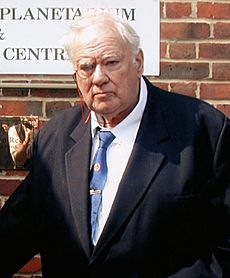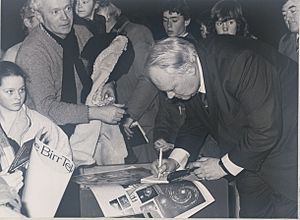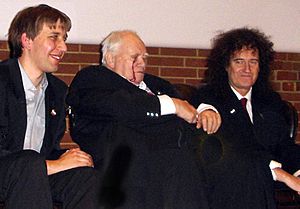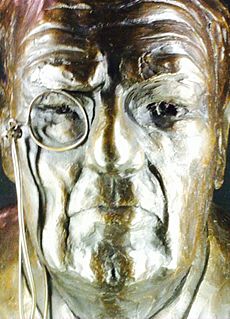Patrick Moore facts for kids
Quick facts for kids
Patrick Moore
|
|
|---|---|

Moore in 2002 at the opening of the South Downs Planetarium & Science Centre
|
|
| Born |
Patrick Alfred Caldwell-Moore
4 March 1923 Pinner, Middlesex, England
|
| Died | 9 December 2012 (aged 89) Selsey, West Sussex, England
|
| Resting place | Chichester, West Sussex |
| Known for | The Sky at Night |
| Awards | |
| Scientific career | |
| Institutions |
|
| Influenced |
|
| Military career | |
| Allegiance | |
| Service/ |
Royal Air Force |
| Years of service | 1940–1945 |
| Rank | Pilot officer |
| Battles/wars | Second World War |
Sir Patrick Alfred Caldwell-Moore (4 March 1923 – 9 December 2012) was a famous English amateur astronomer. He became well-known as a writer, researcher, radio speaker, and TV presenter.
Patrick Moore was the president of the British Astronomical Association. He also helped start and led the Society for Popular Astronomy. He wrote over 70 books about space. He was the presenter of The Sky at Night on the BBC, which is the world's longest-running TV show with the same presenter, starting in 1957. He was especially good at observing the Moon and created the Caldwell catalogue of space objects. People easily recognized him on TV because of his quick way of speaking and his special eyeglass, called a monocle.
Beyond astronomy, Patrick Moore appeared on the video game TV show GamesMaster. He taught himself to play the xylophone and piano, and he even wrote music. He enjoyed playing cricket, golf, and chess. He wrote many popular science books and also some fiction stories. He was against fox hunting and was a strong critic of the European Union. He served in the Royal Air Force during World War II.
Contents
Early Life and Learning
Patrick Moore was born in Pinner, Middlesex, England, on 4 March 1923. His family later moved to Bognor Regis and then to East Grinstead, where he grew up. He had heart problems when he was young, so he was taught at home by tutors.
He became interested in astronomy when he was just six years old. At age eleven, he joined the British Astronomical Association. When he was 14, he was asked to manage a small observatory in East Grinstead after his teacher, William Sadler Franks, died in an accident. He started wearing a monocle at 16 because one of his eyes was weaker.
Serving in World War II
During World War II, Moore joined the Home Guard in East Grinstead. He later joined the Royal Air Force Volunteer Reserve in 1941. He trained in Canada to be a navigator and pilot. He returned to England in 1944 and became a pilot officer. He served until October 1945.
Career in Astronomy
After the war, Patrick Moore decided not to go to University of Cambridge. He wanted to learn and work on his own. His first book, Guide to the Moon, was published in 1953. He worked as a teacher from 1945 to 1953. He also translated a book by a French astronomer, as he spoke fluent French. He wrote his first fiction book, The Master of the Moon, which was one of many space adventure books for young people.
While teaching, he set up a 12½ inch reflector telescope at his home. He used this telescope for many years. He was very interested in the far side of the Moon, which is mostly hidden from Earth. He studied glowing areas on the Moon's surface and called them transient lunar phenomena.
The Sky at Night TV Show
Patrick Moore first appeared on TV in a debate about flying saucers. He was then asked to present a live astronomy show. The show was named The Sky at Night and started on 24 April 1957. The first episode was about the Comet Arend–Roland. The show was made for everyone, from people who just liked space to professional astronomers.
Moore presented almost every monthly episode. In July 2004, he got very sick from food poisoning and missed one show. He is in the Guinness World Records book for being the world's longest-serving TV presenter. From 2004 until his death, he presented the show from his home because arthritis made it hard for him to travel. He always stayed with the BBC, even when other TV networks offered him more money.
In 1959, the Russians let Moore be the first Westerner to see photos from their Luna 3 probe. He showed them live on TV. He also visited the Soviet Union and met Yuri Gagarin, the first person in space. For the 50th episode of The Sky at Night in 1961, he tried to show a live view of a planet through a telescope, but clouds blocked the view.
Other Astronomy Work
In 1965, he became the director of the new Armagh Planetarium in Northern Ireland. He stayed there until 1968. He helped develop the Planetarium and traveled to Japan to get a special projector. He also helped with the Birr Telescope in Ireland and the Herschel Museum of Astronomy in Bath.
In June 1968, he moved back to England. During the NASA Apollo program, he was a presenter for the Moon missions. He commented on the Apollo 8, Apollo 9, Apollo 10, and Apollo 11 missions.
He became a member of the International Astronomical Union in 1966. He also created the Caldwell catalogue, which lists 109 star clusters, nebulae, and galaxies for amateur astronomers to observe. In 1982, an asteroid was named 2602 Moore in his honor.
In February 1986, he presented a special Sky at Night episode about Halley's Comet. In 1998, a tornado damaged his observatory, but it was rebuilt. He also campaigned against the closure of the Royal Observatory, Greenwich. He loved episodes of The Sky at Night that showed eclipses, saying a total eclipse of the Sun was one of nature's greatest sights.
Patrick Moore was a presenter for the total eclipse in England in 1999. He was also a patron of the South Downs Planetarium & Science Centre, attending its opening in 2001.
In 2007, a special 50th anniversary episode of The Sky at Night was broadcast. It featured guests like Jon Culshaw and Brian May. In 2011, he celebrated the 700th episode of the show from his home. He presented it with guests like Professor Brian Cox and Lord Rees.
By 2012, due to arthritis and an old spinal injury, he could no longer use a telescope. However, he continued to present The Sky at Night from his home.
Other Interests and Public Life
Patrick Moore was a well-known public figure because of his long TV career and unique personality. In 1976, he was part of an April Fools' Day joke on BBC Radio 2. He announced a special event where listeners could jump at a certain time and feel weightless. Many people called the BBC saying they felt it! He also helped start the International Birdman event in Bognor Regis.
He appeared on other TV and radio shows, including the BBC Radio 4 show Just a Minute. From 1992 to 1998, he played the character of GamesMaster on the Channel 4 TV series GamesMaster. This character knew everything about video games and gave challenges and tips.
Moore enjoyed acting in local plays. He also appeared in comedy shows like The Goodies and the Morecambe and Wise show. He had a small role in The Hitchhiker's Guide to the Galaxy on radio. He liked the science fiction TV series Doctor Who and Star Trek. He even made a short appearance in a Doctor Who episode in 2010.
He was a keen amateur chess player and was vice president of the Sussex Junior Chess Association. He played for Sussex when he was young.
Moore was also an enthusiastic amateur cricketer. He played for the Selsey Cricket Club and for the Lord's Taverners, a charity cricket team. He was a good leg spin bowler. He also played golf.
Until his arthritis stopped him, Moore was a talented pianist and xylophone player. He started playing the xylophone at 13. He wrote many pieces of music, including two operettas. He even performed for the Royal Family and played a duet with famous percussionist Evelyn Glennie. In 1981, he played the Sex Pistols' "Anarchy in the U.K." on the xylophone at a Royal Variety Performance.
He traveled a lot before his health problems, visiting all seven continents, including Antarctica. He said his favorite countries were Iceland and Norway. In 2006, he had a pacemaker fitted due to a heart problem.
He was good friends with Queen guitarist and astrophysicist Brian May, who sometimes appeared on The Sky at Night. Brian May bought Moore's home in 2008 and let him continue living there. May, Moore, and Chris Lintott wrote a book together called Bang! The Complete History of the Universe.
Patrick Moore believed he was the only person to have met the first aviator, Orville Wright, the first man in space, Yuri Gagarin, and the first man on the moon, Neil Armstrong.
Honors and Awards
In 1945, Patrick Moore became a Fellow of the Royal Astronomical Society (FRAS). In 1977, he received the society's Jackson-Gwilt Medal. He was made an Officer of the Order of the British Empire (OBE) in 1968 and a Commander (CBE) in 1988. In 1999, he became the Honorary President of the East Sussex Astronomical Society.
In 2001, he was knighted for his work in making science popular and for his broadcasting. This meant he became "Sir Patrick Moore." In the same year, he became an Honorary Fellow of the Royal Society (HonFRS), which is a very special honor for an amateur astronomer.
In 2002, Buzz Aldrin gave him a British Academy of Film and Television Arts (BAFTA) award for his contributions to television. He also received honorary degrees from the University of Leicester.
Personal Life and Passing
World War II had a big impact on Patrick Moore's life. He said his only romantic relationship ended when his fiancée, Lorna, a nurse, was killed by a bomb in London in 1943. He never married, saying there was no one else for him.
Moore was very close to his mother, Gertrude. She was an artist and lived with him. She painted friendly aliens, which she called "bogeys," and sent them out as their Christmas cards.
Patrick Moore passed away on 9 December 2012, at his home in Selsey, at the age of 89. In 2014, the Science Museum, London acquired many of his personal items, including his The Sky at Night scripts, observation books, and his telescope.
See also
 In Spanish: Patrick Moore para niños
In Spanish: Patrick Moore para niños
- Jack Horkheimer, host of the astronomy show Jack Horkheimer: Star Gazer (American counterpart)




